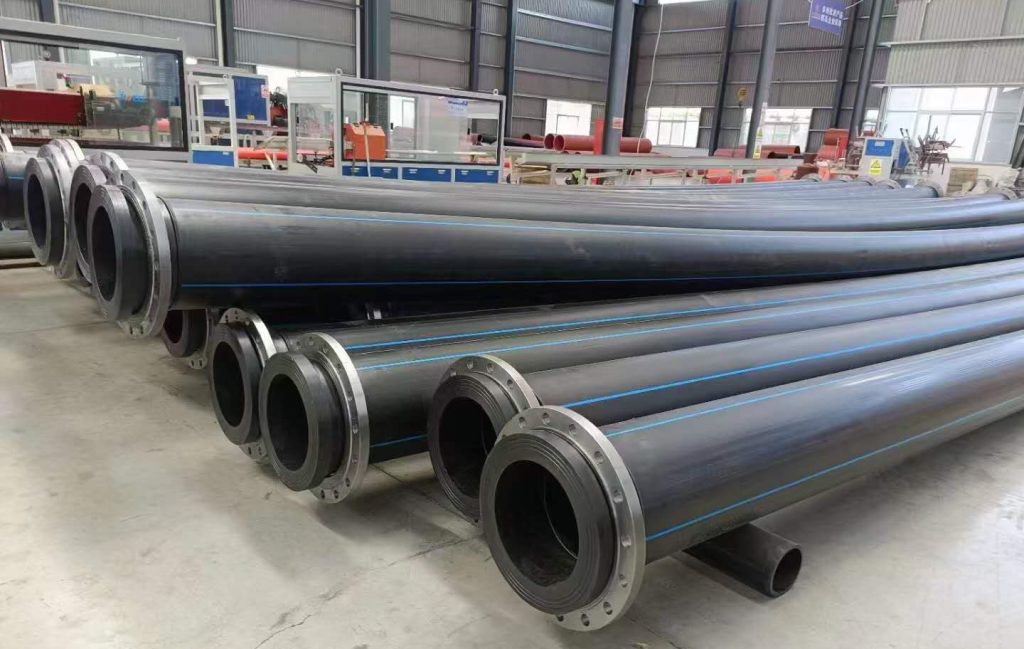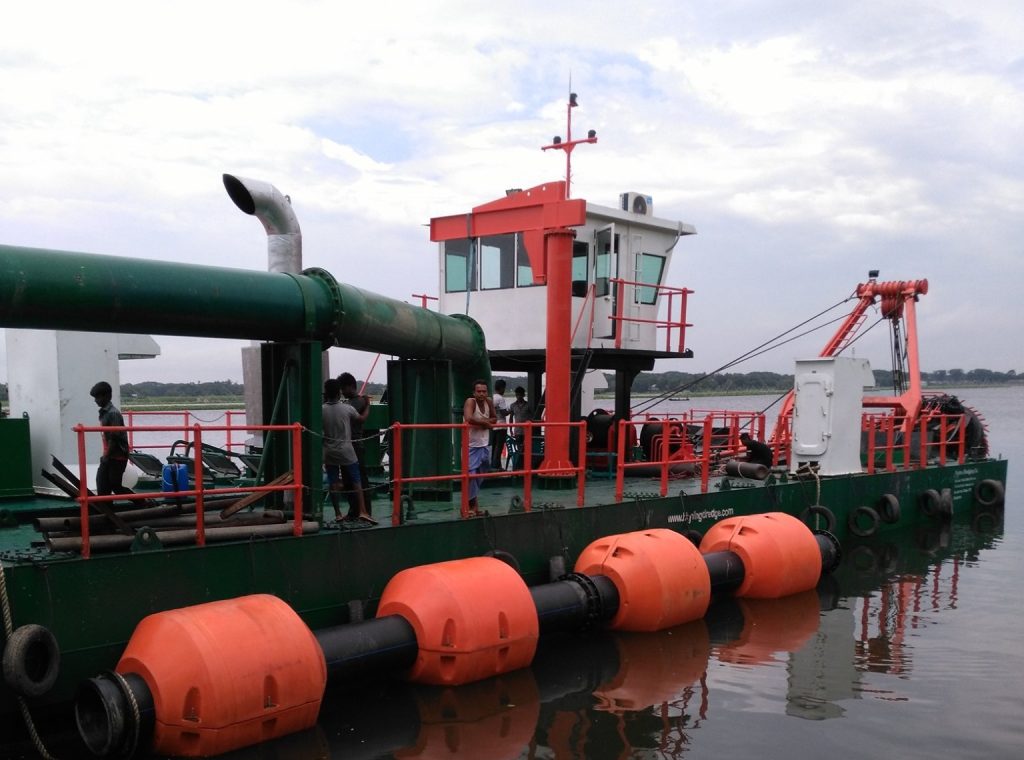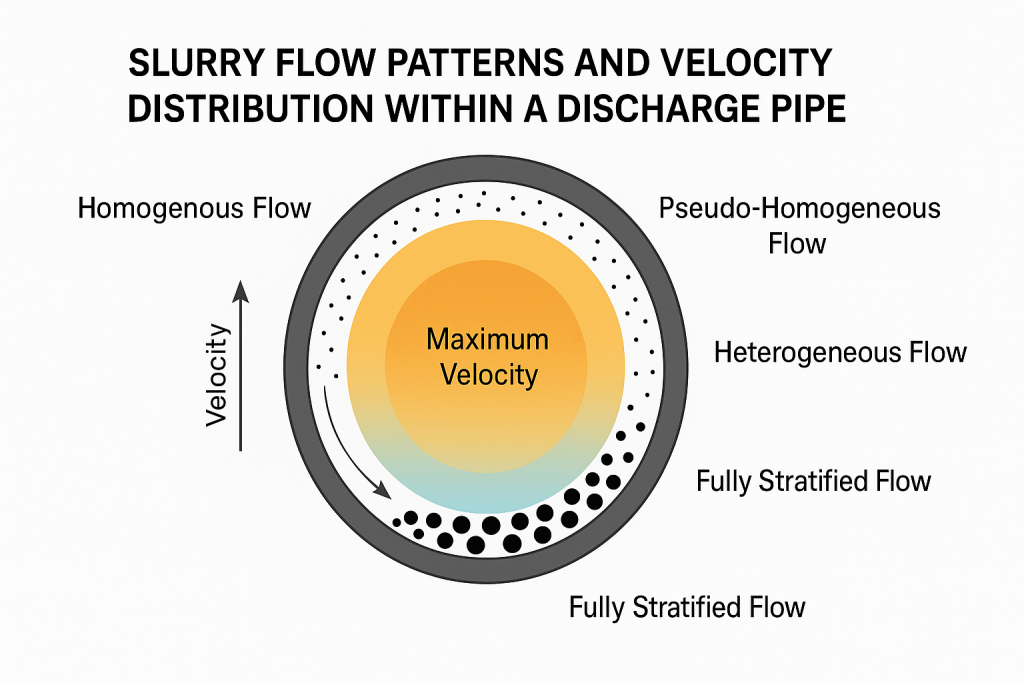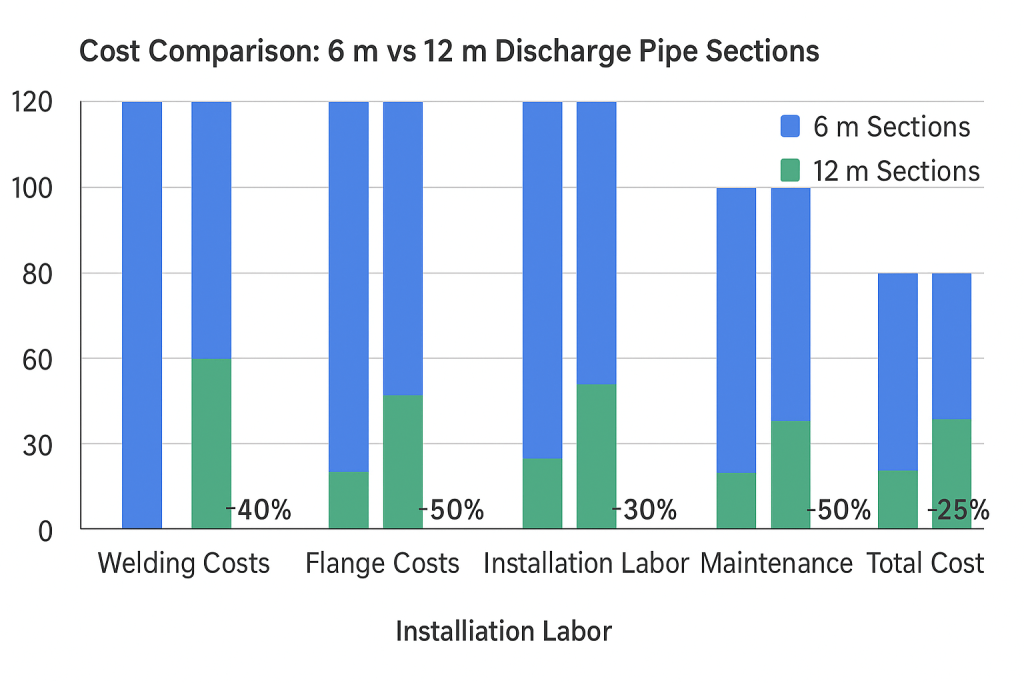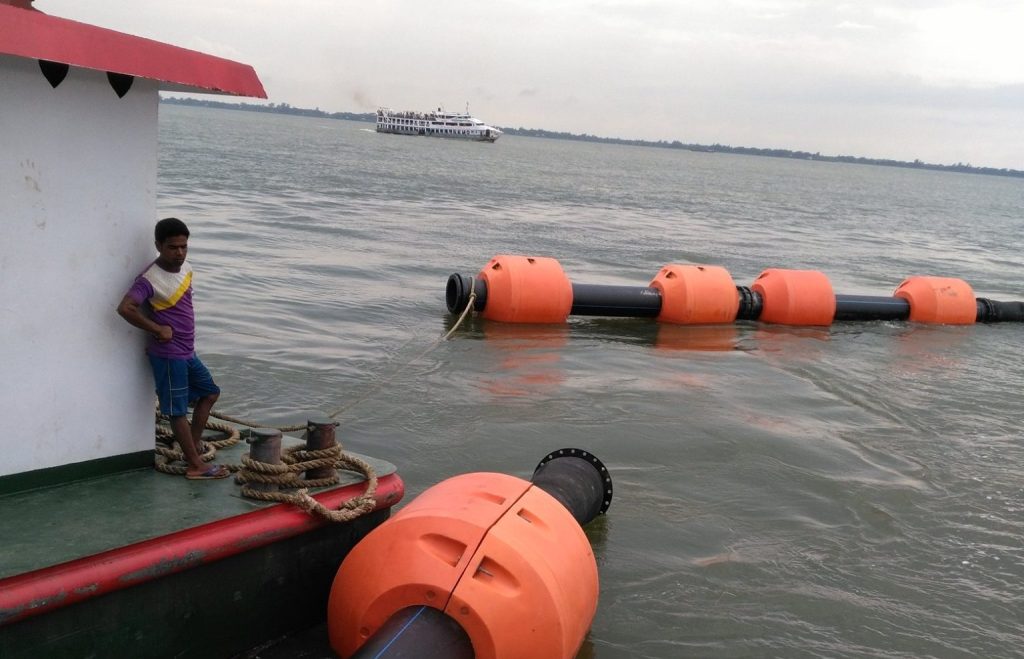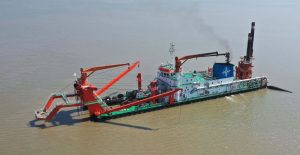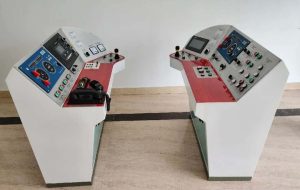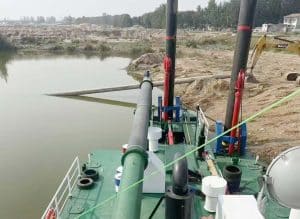Quick Reference: Discharge Pipe Key Specifications
| Specification | Range | Notes |
|---|---|---|
| Diameter | 200mm – 700mm | Depends on dredger size |
| Distance | Up to 3,000 meters | Booster stations for longer distances |
| Materials | Steel, HDPE, SA1750CR | HDPE preferred for flexibility |
| Flow Speed | 3-4 m/s optimal | Prevents settling and wear |
What Is a Cutter Suction Dredger Discharge Pipe?
A cutter suction dredger discharge pipe is the lifeline that carries dredged material from the vessel to its final destination. Think of it as a giant straw that sucks up sediment and water, then pushes this mixture through a pipeline system.
This pipe connects directly to the dredger’s main pump outlet. From there, it transports the slurry mixture across long distances to disposal areas or land reclamation sites. The entire system works continuously, which means the discharge pipe never gets a break during operation.
Most importantly, the discharge pipe must handle abrasive materials without breaking down. Sand, rocks, and debris constantly flow through these pipes at high speeds. That’s why proper design and material selection make all the difference between success and costly downtime.
Modern cutter suction dredger showing the discharge pipe system extending from vessel to shore
Key Specifications and Dimensions
Discharge pipe specifications vary dramatically based on project requirements. However, certain standards have emerged across the industry that guide most installations.
Pipe diameters typically range from 200mm for smaller operations up to 700mm for large-scale projects. The sweet spot for most commercial dredging operations falls between 600mm and 650mm. This size balances flow capacity with manageable installation costs.
Distance capabilities reach impressive lengths. Standard setups handle up to 3,000 meters without additional equipment. Beyond this distance, booster stations become necessary to maintain adequate pressure and flow velocity.
Real-World Performance Data
- CSD650 Model: 650mm diameter, 7,000 m³/h capacity, 18m dredging depth
- CSD600 Model: 600mm diameter, 6,000 m³/h capacity, 16m dredging depth
- Large CSD800: 750mm diameter, 27.5m maximum depth capability
Flow rates match these dimensions accordingly. A 650mm pipe typically handles 7,000 cubic meters per hour, while 600mm systems manage around 6,000 cubic meters hourly. These numbers represent continuous operation under normal conditions.
Essential Components of the Discharge Pipe System
The discharge pipe system includes several critical components that ensure smooth operation. Each component serves a specific purpose, yet they all work together as an integrated system.
Sniffer valves (also called deaerator valves) solve one of dredging’s biggest headaches: trapped air. When air gets stuck in high sections of the pipeline, pumps can’t prime properly. These valves automatically release trapped air during startup, preventing costly delays.
Non-return valves act like one-way doors for slurry flow. They prevent backflow when discharge pressure drops suddenly. This protection keeps the dredger from flooding and protects expensive pump equipment from damage.
Vacuum relief valves prevent dangerous vacuum conditions in the suction line. When blockages occur or during system shutdown, these valves allow air to enter and equalize pressure. This prevents pump cavitation and makes cleaning much easier.
Essential flange components in a typical discharge pipe system layout
Hydraulic dredge valves control slurry flow throughout the pipeline. These specialized valves handle abrasive mixtures and high pressure conditions that would destroy regular valves. They’re built tough because they face constant punishment from sand and debris.
All these components require regular maintenance and monitoring. A single valve failure can shut down an entire dredging operation, making preventive care essential for project success.
Materials Used in Discharge Pipe Construction
Material selection dramatically affects both performance and costs over the pipe’s lifetime. The wrong choice leads to frequent replacements and project delays.
Steel pipes remain popular for their strength and availability. However, they suffer from corrosion issues, especially in saltwater environments. Traditional Q345 steel works for basic applications but shows significant wear under demanding conditions.
High-density polyethylene (HDPE) has gained popularity for good reasons. HDPE offers superior corrosion resistance and weighs much less than steel. The flexibility also helps during installation and reduces stress points that cause failures.
Additionally, modern cutter suction dredgers increasingly use HDPE for floating pipeline sections. The material’s buoyancy characteristics and flexibility make it ideal for these applications.
SA1750CR wear-resistant composite plates represent the cutting edge of pipe materials. These advanced composites last up to five times longer than traditional materials under identical conditions. The initial cost is higher, but the longevity more than compensates through reduced downtime and maintenance.
Pro Tip: Manufacturing process matters as much as material choice. Pipes made using the “first roll, then weld” method show significantly better durability than “first weld, then roll” alternatives.
The manufacturing process creates crucial differences in performance. Proper rolling before welding avoids brittle cracks and weak seam points. Vertical weld seams on inner walls create turbulence that accelerates wear and causes premature failures.
How Discharge Pipes Work: Flow Dynamics Explained
Understanding flow dynamics helps optimize system performance and prevent costly problems. The physics involved might seem complex, but the basic principles are straightforward.
Slurry velocity must exceed critical thresholds to keep sediments suspended. If flow speed drops too low, particles settle and create blockages. Laboratory testing shows critical velocities ranging from 1.8 to 4.27 meters per second, depending on pipe diameter and sediment characteristics.
The optimal operating range falls between 3-4 meters per second for most applications. This speed provides a safety margin above critical velocity while avoiding excessive wear from high-speed flow. Maintaining this range requires careful balance between pump power and pipe sizing.
Excessive velocity creates serious problems. Water hammer effects increase dramatically at high speeds, leading to pipe bursts and system failures. Coarse particles and high-density materials amplify these problems, making flow control even more critical.
Slurry flow patterns and velocity distribution within a discharge pipe cross-section
Pressure considerations play an equally important role. The system must maintain adequate pressure to transport material over long distances while avoiding dangerous pressure spikes. Booster pumps help maintain consistent pressure in extended pipeline systems.
Flow calculations must account for elevation changes, pipe friction, and material density variations. Hydraulic engineering principles guide these calculations to ensure reliable operation under varying conditions.
Common Operational Challenges and Solutions
Every discharge pipe system faces predictable challenges. Knowing these problems in advance allows operators to implement effective solutions before issues become critical.
Air entrapment tops the list of common problems. Air bubbles trapped in high pipeline sections prevent proper pump priming and reduce flow efficiency. The solution involves proper deaeration procedures during startup and strategically placed sniffer valves.
Blockages occur when debris enters the system or when flow velocity drops below critical levels. Roots, plastic waste, and large rocks cause most blockages. Regular system monitoring and proper intake screening prevent most blockage issues.
Hydraulic shock damages pipes and fittings when flow conditions change rapidly. Long pipelines carry tremendous momentum, creating dangerous pressure waves during sudden stops. Non-return valves and controlled shutdown procedures minimize these risks.
Energy waste from improper pipeline setup costs operators significant money over time. Short pipelines force pumps to work harder than necessary, increasing fuel consumption and equipment wear. Proper system sizing and impeller selection optimize energy efficiency.
Quick Problem Diagnosis
- Low flow rate: Check for blockages or air entrapment
- High energy consumption: Verify pipe sizing and pump settings
- Frequent breakdowns: Examine flow velocity and material wear
- Pump cavitation: Look for vacuum issues or inadequate suction
Preventive maintenance schedules address most operational challenges before they cause downtime. Regular inspections, proper startup procedures, and systematic monitoring catch problems early when they’re still manageable and inexpensive to fix.
Cost-Saving Design Tips
Smart design choices significantly reduce both initial costs and long-term operating expenses. Small changes in specifications often yield substantial savings over the project lifetime.
Longer pipe sections provide immediate cost benefits. Standard 6-meter lengths require numerous joints and extensive welding. Switching to 12-meter sections cuts fabrication costs substantially while reducing potential leak points. Fewer joints also simplify installation and reduce labor requirements.
Flow speed optimization prevents expensive damage while extending equipment life. Maintaining moderate velocities (3-4 m/s) avoids excessive wear and water hammer effects. This approach costs nothing to implement but saves thousands in replacement parts and downtime.
Proper pump sizing eliminates energy waste from oversized equipment. Overly powerful pumps consume excessive fuel and create unnecessary system stress. Right-sizing pumps based on actual requirements optimizes both performance and operating costs.
Additionally, modular dredger designs allow for easier transportation and setup, reducing mobilization costs significantly.
Cost analysis comparing 6-meter vs 12-meter pipe sections for typical installations
Material selection impacts total cost of ownership more than initial purchase price. Advanced materials like SA1750CR cost more upfront but last five times longer than basic steel. The reduced replacement frequency and lower maintenance costs justify the higher initial investment.
System integration also affects costs. Coordinating pipe specifications with pump capacity and project requirements from the beginning prevents expensive modifications later. This planning approach saves both time and money during construction.
Maintenance Best Practices
Proper maintenance extends equipment life and prevents costly emergency repairs. A systematic approach to pipe system care pays dividends through improved reliability and lower operating costs.
Regular inspection schedules form the foundation of effective maintenance. Visual inspections should occur daily during operation, looking for leaks, unusual vibrations, and signs of wear. Weekly detailed inspections examine valve operation and joint integrity.
Wear monitoring uses thickness measurements to predict replacement needs. Ultrasonic testing identifies thin spots before they become dangerous. This proactive approach allows planned replacements during scheduled downtime rather than emergency shutdowns.
Valve maintenance requires special attention because failures cause immediate operational problems. Monthly testing ensures proper operation of all safety and control valves. Lubrication and adjustment schedules keep valves functioning smoothly under demanding conditions.
Monthly Maintenance Checklist
- Test all valve operations and response times
- Measure pipe wall thickness at predetermined points
- Inspect joint integrity and gasket conditions
- Check support structure stability and alignment
- Verify pressure relief valve calibration
- Document all findings and trending data
Preventive replacement strategies replace components before they fail. Critical items like gaskets, valve seats, and wear plates should be replaced based on operating hours rather than waiting for failure. This approach minimizes unplanned downtime and reduces secondary damage.
Documentation plays a crucial role in effective maintenance. Detailed records track component performance, identify patterns, and guide future maintenance decisions. This information proves invaluable for optimizing replacement schedules and identifying design improvements.
Applications and Versatility
Discharge pipe systems demonstrate remarkable versatility across different dredging applications. Each application presents unique challenges that require specific design considerations and operational approaches.
Land reclamation projects typically require the longest pipeline systems and highest flow rates. These projects move massive volumes of material over extended distances. Pipeline systems may stretch several kilometers from dredging sites to fill areas.
Harbor deepening operations focus on precision and efficiency. Shorter pipeline runs allow for more concentrated operations, but tighter scheduling demands reliable equipment performance. Downtime costs escalate quickly in busy commercial ports.
Maintenance dredging presents different challenges with varying material types and access limitations. Pipeline systems must adapt to changing conditions and work around existing infrastructure. Flexibility and mobility become crucial factors for success.
For comprehensive information about different dredging applications, this ultimate guide to cutter suction dredgers provides detailed insights into various operational scenarios.
Different discharge pipe configurations for land reclamation, harbor deepening, and maintenance dredging
Environmental adaptability ensures reliable operation across diverse conditions. Tropical climates demand corrosion-resistant materials and enhanced cooling systems. Arctic conditions require freeze protection and specialized materials that remain flexible at low temperatures.
Remote location operations face additional challenges with limited support infrastructure. Modular designs and standardized components simplify maintenance and reduce spare parts inventory. This approach proves essential for sustained operations in isolated areas.
Frequently Asked Questions
What determines the ideal discharge pipe diameter for a specific project?
Pipe diameter depends on dredger capacity, required flow rates, and pumping distance. Larger diameters handle higher volumes but cost more to install. The optimal size balances flow capacity with economic constraints.
How do you prevent sediment settling in long pipeline systems?
Maintaining adequate flow velocity above critical thresholds keeps sediments suspended. Proper pump sizing and pipeline design ensure consistent flow rates throughout the system. Booster stations help maintain velocity over extended distances.
What causes most discharge pipe failures?
Abrasive wear from sand and debris causes most failures, followed by corrosion and improper flow velocities. Manufacturing defects and poor installation practices also contribute to premature failures. Regular maintenance and proper material selection minimize these risks.
Can discharge pipes handle different types of dredged material?
Yes, but design parameters must match material characteristics. Coarse sand requires different flow velocities than fine silt. Rocky material demands stronger pipe materials and modified flow patterns. System flexibility allows adaptation to varying conditions.
How do booster stations extend pumping distances?
Booster stations add energy to the slurry flow, maintaining adequate pressure and velocity over long distances. They’re typically installed every 1,000-1,500 meters depending on terrain and material characteristics. This approach enables pumping distances well beyond normal limits.
Conclusion
Discharge pipes represent the critical link between dredging operations and project success. Proper design, material selection, and maintenance ensure reliable performance while minimizing costs. Understanding flow dynamics, operational challenges, and application requirements guides effective system implementation.
Smart design choices like optimized pipe lengths, appropriate materials, and proper flow velocities deliver significant cost savings over project lifetimes. Regular maintenance and proactive monitoring prevent expensive failures while extending equipment life.
The versatility of modern discharge pipe systems enables successful operations across diverse applications and environmental conditions. From land reclamation to harbor maintenance, these systems adapt to meet specific project requirements while maintaining operational efficiency.

